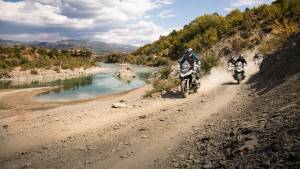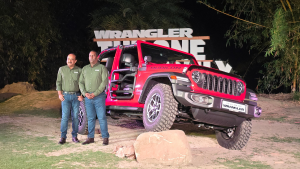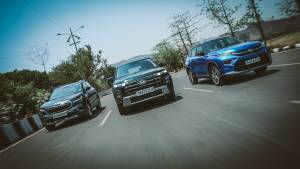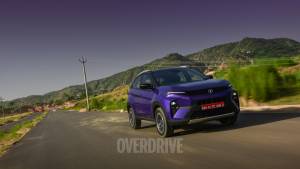Ride-craft
Team OD
Published: August 26, 2011, 12:49 AM IST
I never thought that the stretch between the late apex of turn one at Sriperumbudur and the turn-in point for corner two was going to be the place where an epiphany would occur. Heck, I didn't know just a few hours ago that corner 1 at Sriperumbudur - a fast, bumpy, nasty feeling stretch of scarred, right turning tarmac - had a late apex at all. I also, I might add, didn't know that I had it in me to keep the throttle pinned on a piddly (relative term) 160cc machine as it waggled its bars through this stretch.
What triggered it? A chap called Sweetman (the chap leading me in main pic) in white-blue leathers, a Nicky Hayden replica Arai lid, mounted on a red-green-white Red Rooster Honda CBR600RR giving me an emphatic thumbs up for most of the front-straight.How does one upright thumb and two motorcycles trigger such a great feeling that I nearly ran straight on at turn two for the first time in two days choked on delightand emotion?
Welcome to California Superbike School. It dawned, erm, early. My close friend Josh and Kartik, a fellow pen-wielding motorcycle maniac made the familiar pit lane at an ungodly 6am. The only sound was the squeaking of three pair of motorcycle boots. Within minutes, the rumble and whir of big and small motorcycles had filled up pit lane. And then, out of a duo of Innovas jumped the stars of the show. In the surfer dude duds, Keith Code. Only the most famous motorcycle trainer in the world. Then, jovial Andy Ibbott, only the most famous motorcycle trainer in the UK, a man who counts many, many top-level (MotoGP and World Superbikes) riders as his students. In the specs, intense Steve Brouggy, whose work - in addition to Andy and Keith - I have downloaded, printed out, filed and re-referred to for years and years. I thought I'd be star-struck when I first sauntered down the MotoGP paddock at Valencia. These were stars there. People whose words I've tried to put in action, over and over for the better part of the last 15 years.
Within minutes, it's obvious that their skills - on a bike and their ability to teach are both towering, but their egos aren't. Keith hangs around with a sparkling almost avuncular interest as we sort the paper work, get our kit inspected and our motorcycles scrutiny-d. I'm riding one of the School's TVS Apache 160s sourced from partners TVS Racing - just stick my number, White 7, on the bike and go. Well, the first Apache had a sticky throttle so second time lucky. Josh got himself an R15 for the school, and had to nix the mirrors, tape over the indicators, tail lamps, speedo and headlamps (prevents broken shards from littering the track should you crash, tail lamps and speedo are hidden to remove distractions.)
All set? Andy takes the first of the ten classes I would be attending over the next two days. The surprise is that none of what Code, Andy and on day two, Brouggy discuss in the classroom is rocket science. The teaching style raises questions, brings common riding understanding down to the basics - why we do it, should we do it, how to do it and when to do it. The answers usually come from the students, which leaves none of the 20 riders in the classroom (three batches of 20 students run parallel on staggered schedules each day).
When the answers do come, they stay in your head. And before the knowledge leaves you, you get on track for 20 minutes to practice something very specific. The CSS uses a well-proven idea to help - use only a gear and no brakes. Takes away distraction and helps you focus on what you should be doing. You begin each day with one gear and no brakes and end it going very very rapidly using three-four gears and moderate brakes.
Through each day, each classroom session builds a logical tower of building blocks for you. On day one, the base level, you learn in order, for instance, throttle control - which is responsible for more aspects of your motorcycle's behaviour than you can ever imagine. Once you've got that throttle under some semblance of control, you learn to turn the motorcycle and then use your newly learned throttle control.
Get the bike turning right and it's time to learn where to turn it. Figure out where to turn it and it's time to learn how to look where you need to be going, and to be able to begin the turn where it needs to - without having to look. It's a beautifully structured programme that walks the fine line between the wonder of learning and the exhaustion of overload. There's a 40-minute break between your classroom and track sessions - just enough to wrap your head around what you just learned, to drink some water to stave off Chennai's heat and to chat with friends before the next activity.
When you're on track, you have an instructor assigned to you for the day. He has three charges and his job is to ensure you get the learning done - by demo-ing the skill on track and then watching you get it right. Darren Sweetman from the New Zealand CSS was my coach the first day. He patiently watched me get each skill right. Get faster, get more confident and get more stable through the two days. I followed him for countless laps, watching how it's done and then showed him my understanding on the next laps. My reward? A vehement headshake, a cheerful thumbs up and a waiting smile back in pitlane.
At the end of the each session, you park your steed, remove the helmet, grab a water or lemon juice and find your coach. Darren would be waiting for me. He'd start by asking for a recap of what we learnt and what we needed to do on track. Then move on to places on the track we loved riding and corners we couldn't get the hang of. We work the kinks out and go back out knowing that the next session would be better.
What you do not realise at all is the fact that slowly but surely, your pace is going up. Your familiarity with the race track grows. Your lines shape up, apexes come naturally and corners formerly feared come around to some sort of working arrangement. It's a wonderful feeling. What most people do not realise is that most of us Indian motorcyclists are self-taught. We learn habits good and bad along the way and in the absence of a better way to learn, we figure out what works for us. Some of it fits, and other bits don't. But the simple feeling of having someone watch over you, correct you and encourage you is liberating. And towards the end of the second day something almost magical happens. You get lap after lap right in a way you haven't dreamt of. Is it the fastest you've ever gone? Oh hell, yes. Are you a bonafide racer now? Nope. But you nailed that lap. Every turn-in point, apex and exit was correct. Your form was impeccable, the tyres have no chicken strip left but you didn't take any chances either. You reached out and touched the limit of traction. With a firm handshake rather than a shaky poke.
And that's what CSS is about. It, as Keith Code says, isn't a race school. It's a riding school. It uses the safety of the racetrack to give you the building blocks of going faster, better and safer on the motorcycle. It gives between one and four riding days of incredibly rewarding motorcycling and in its current form, all this comes at a shockingly low price tag as well.
By the time all this plays out in my head, Darren has once more taken station on my tail. He's wondering why I've suddenly lost tautness of line and precision for the past few corners. I was doing so well moments ago... I turn my head and give him a thumbs up. He has an exasperated sort of shrug. Then I smoothly roll the throttle back on, turn 4, my favourite, is coming up. And I know just what I need to do with it.
Turn 6, Darren passes me and waves as he disappears into the distance, on his way to his other students. His job with me, for now, is done.
Until the next California Superbike School returns to India. It'll be back. And I promise you, so will I.
In conversation with Keith Code
OVERDRIVE: How did the idea of California Superbike School come to you, how has it been developing and how is it going?
KEITH CODE: It's been an exciting 31 years (laughs). The idea for this school came from my feeling that riders would be able to learn much more and their learning would be vastly accelerated if they are able to get out in an environment where they don't have the confusion they have on streets or the mountain roads they like to ride on. I was positive that this would be a better learning environment. When I quit racing at the end of the '70s I wanted to stay around motorcycles rather than go back to designing shoes that I used to do before racing superbikes. So I started the California Superbike School and we have been to some 20 countries and have had about 175,000 students.
OD: You have run the school all over the world. How has the India experience been?
KC: Fantastic! It is incredible. I did not have an idea what it would be like to come to India. It is all about the students. I am just fascinated by the country but the students here are very willing to learn. They are here for a very good reason and they want to improve themselves. We have had no trouble in getting the students to understand all the techniques we train here so it has been very fantastic for me.
OD: Are Indian students different from the students you deal with all over the world?
KC: Well, that is the interesting thing. Over the years we have found that no matter what country riders come from they still suffer from the same problems. They still have their survival instincts on a motorcycle. I have isolated eight that are counter to what a rider needs to have on a motorcycle. Our number one enemy is our instinct. So the school is geared to push the instincts out and bring the correct techniques in.
OD: Is this a school for racers?
KC: No, not just for racers. I think at least half or three-quarters of the students here today have never been to a race track before. Probably more than half of them are not racers. Only a few of them have actually had track and racing experience before. The basic techniques apply on the race track for racing as well as on the road for real world riding. They are fundamentals and you cannot get around them. They cannot be ignored. You have to use these things or else you will always have problems.
OD: Let us go back to the fact that you have trained a lot of senior and respected racers. Who was the most impressive racer that you have worked with?
KC: All the guys that I have worked with have won world championships. They all have their own aspects, their own personalities and each of them is very impressive. Some of them are really skilled at seeing what is there in front of them, some of them have a kind of bravery factor and some of them are very analytical. The only similarity between them is that they go out and win. But individually and personally, they are quite different. It is a very difficult question because they all are staunch individualists. They want to able to succeed at the sport. They have a burning desire to succeed and that is something that they all have in common. But otherwise it is just as varied as you and me probably.
OD: When are you coming back?
KC: We do not have the dates yet but we are coming back to India next year. It is definitely in the planning stages to come back and continue with the training of Indian riders since it has been very successful. Last year we had 24 students and this year we had 90, which is a huge increase.
In conversation with TT Vardharajan
OVERDRIVE: What is your association with California Superbike School?
TT VARDHARAJAN: Through Preethi we sponsored the CSS last year. We brought coaches from the UK and trained 24 of India's top riders and the estimate is that 7 or 8 of them are already back at school this year. The others are not back only because of the lack of spots. This shows what they took back from this school last year. Rajni was also on the track today like the last year and he sees a benefit from this school. As Keith often says, "You are very fast but how do you get faster?" There are certain basic techniques that they start with and if you ignore them you are not going to get any faster. And the other thing that I wanted to say is that this year we have a global team here. We have Keith and Dillon from the US, Andy, Gary and Glenn from the UK, Steve Brouggy from Australia and Darren Sweetman from New Zealand so it is a global school this time. We are very privileged to have Keith together with his whole team for the first time in CSS history. We have the best talent in the world to train us.
OD: You've been going to these schools since the 1990s. How has this changed the way you ride motorcycles?

TT: Passion is one thing but riding ability is another thing, something I was lacking in sadly. I rode in seven South India rallies in the '70s and I do not how I managed but I was okay at that time. But when I went to Keith's school for the first time it totally changed the way I rode. Be it highway or street, my confidence level is 1000 per cent up. And I am graduating from Royal Enfield Bullets to 1000cc CBRs and even with these bikes I am extremely confident. My personal take is that in the US 70 per cent of the riders are street riders and they come to CSS to pick up skills for the streets. So it is not that this school is totally focused towards track or racing. And as you know the accident rates in India are extremely high so it would be a great help if we could keep the school running on a permanent basis.
OD: What are the future plans for CSS in India and how are you going to support it?
TT: This year we have brought in TVS Racing. Red Rooster Racing supported us last year and they provided us bikes this year as well. Dinesh Reddy (RRR) has been helping us with the finances too. TVS has been very kind to provide us 24 bikes for the riders this year. Next year I am hoping to involve them to a greater extent. We will probably tie up with the UK school because they are closest to us. The event would be in Chennai but if the Delhi track opens up we will have an event there too.
OD: When do you think ourreaders can get dates so that they can sign up?
TT: As far as the Chennai track is concerned, as soon as this event is over I will check with Andy and book the next year. But we will have to negotiate for the Delhi track and see if we can get some dates for this school as the track is just opening up. But it is definitely happening in Chennai next year. And if we are able to fix dates, it will happen in Delhi too. We would like to do it in one shot only as these guys have their calendars booked. I would like to bring them in January as that is their lean season.
Price (Ex-Delhi)
Starts Rs 1,30,764
Starts Rs 1,30,764
Displacement
499cc
499cc
Transmission
5-Speed
5-Speed
Max Power(ps)
27.20
27.20
Max Torque(Nm)
41.30
41.30
Mileage
-NA-
-NA-
Related Stories
Advertisement
Advertisement
Top Stories
Advertisement
Latest Videos
Most Popular
Advertisement
Network18 Updates
Compare














